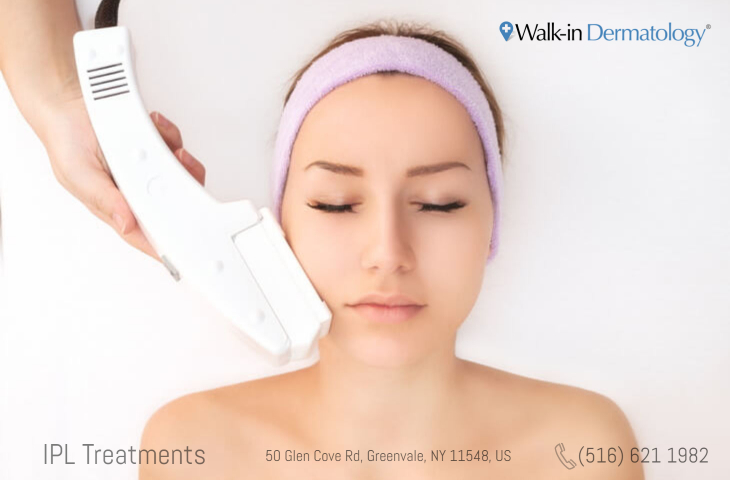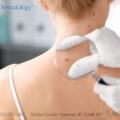Tues: 8:30am - 3:00pm
Wed: 12:00pm - 6:00pm
Thurs: 8:30am - 3:00pm
Fri: Closed
Sat: 8:30am - 12:30pm
Sun: Closed
Greenvale, NY 11548
IPL Photofacials for Acne: How It Works, and Does It Work?


We all experience acne at one point or another, typically in our teen and young adult years, and for most of us, these acne issues go away. But some of us are left with acne problems that last much longer than we would like, leaving us to deal with anywhere from mild to severe acne conditions that can bother us for years.
At Walk-in Dermatology, we recommend the IPL photofacial treatment for patients who need help with their acne. This laser-based treatment is best at targeting the causes of acne under the skin while keeping the top layer of the skin completely safe. In this article, we discuss exactly how IPL photofacial works and how acne can be treated with it.
What is IPL Photofacial? What Does It Do?
IPL (intense pulsed light) and photofacial are occasionally used interchangeably, but these terms do not exactly mean the same thing. Photofacial is the general term for skin treatments that utilize light-based technology. There are two major photofacial types – LED photofacials for light-emitting diode technology, and IPL photofacials for intense pulsed light technology.
So what is the difference between the two? IPL photofacial uses high-intensity pulses, meaning the treatment can lead to more visible changes. LED photofacial is a much gentler and lighter treatment therapy that is used for patients who want to boost collagen levels in their face and neck.
As IPL treatments can treat a greater range of conditions than LED, most doctors and clinics refer to IPL photofacial when talking about photofacial treatments.
Understanding How IPL Photofacial Works
The science behind light-based treatments is simple, although most patients may find it confusing the first time. IPL photofacial utilizes the body’s natural healing processes to create significant changes to the targeted area.
The laser technology emits quick pulses of intense light to the targeted area. IPL is the preferred type of photofacial because it uses a broad-spectrum light source, making it an applicable treatment for a variety of skin problems, including acne, age spots, rosacea, acne scars, and more.
Unlike the typical laser procedure which utilizes just a single light wavelength, IPL treatment releases a set of different pulsed light wavelengths, similar to the flash of a photo. This makes the pulses less focused and more scattered than what you would achieve with typical laser devices. Scattered intense pulsed light can penetrate to deeper layers of the skin beneath acne and fine lines without causing damage to the top layer.
When the pulses touch the skin, the energy is absorbed by pigment cells and turns into heat. This heat beneath the surface of the skin can destroy spots, freckles, hair follicles, and the bacteria that may be causing the patient’s acne. While IPL can be used on any part of the body, it isn’t recommended on uneven areas.
Is IPL Photofacial a Good Treatment for Acne?
If you have acne and you are looking for the best solution to get rid of it, then IPL photofacial is the solution you need. More and more doctors are recommending IPL photofacials for patients with severe acne or acne scarring, as well as other conditions like sun spots and age spots (through targeting blood vessels), and fine lines.
With just a few sessions, IPL treatments can clear up even the most extreme cases of facial acne and/or acne scarring. With alternatives like oral antibiotics that can be harmful to some patients, IPL therapy is a safe and easy option for acne removal.
When dealing with acne, IPL photofacials treatments generally utilize three filters or wavelengths: 420 nm or blue light, 560 nm of yellow light, and 590 nm of red light. These three filters provide their own properties:
- 420 nm (blue light): Destroying certain acne bacteria
- 560 nm (yellow light): Tending swollen acne lesions
- 590 nm (red light): Paralyzing overactive oil glands in the skin
What is the Typical IPL Laser Treatment for Acne?
The exact treatment needed will depend on the severity of the patient’s acne condition. The typical skin treatment course should be about 4-6 sessions, each session a few weeks apart. Sessions can last anywhere from 15-20 minutes or up to an hour; this depends on how much skin needs to be treated.
Each treatment begins with a protective cooling gel being applied to the targeted area. This will help keep the top layer of the skin safe from the heat without preventing the IPL flashes from penetrating the skin.
Afterwards, the IPL device is pressed to the treated area and a flash of light is emitted into the skin. The doctor should then move the tip along the skin, emitting a flash at every different point. This process can be repeated with each filter if desired by the doctor or technician.
The treatment ends with the skin being wiped clean and the patient given a post-treatment product to help with the healing process.
Healing and Recovery: How Long Does IPL Take to Heal?
A great advantage of IPL treatment is that it causes minimal damage to the top layer of the skin, meaning healing and recovery is quicker than with other types of skin and acne treatments.
After each treatment, patients should feel like they have a mild sunburn on the treated area; this can last anywhere from 4-6 hours. Side effects may also include slight bruising and reddening for a day after the treatment, and some peeling after the first few weeks. No serious side effects should be expected.
Patients can expect to see some improvements after their first treatment, but full results won’t start to become visible until after the first few treatments are done and they are several weeks into their treatments. To maximize your recovery, follow the following tips:
- Use lotion to moisturize the skin daily
- Wash the face a few times a day with cleanser
- If the skin is in pain, don’t apply makeup
- Always use sunscreen with at least an SPF of 30 if you plan to go outside to avoid sun damage, as sun damage is very harmful to the skin
IPL Photofacial Acne Treatment: Your Top Acne Solution at Walk-in Dermatology
At Walk-in Dermatology, acne is one of the most common skin care problems that first-time patients seek to treat. We have treated countless patients with acne problems, from mild to severe cases, and we recommend IPL photofacial acne treatment for patients looking for an easy yet effective solution.
With IPL photofacial treatments, your acne, sun spots, and other skin conditions can be significantly reduced in just a matter of weeks. Call us or book your appointment through our website to learn more about IPL treatment and professional skin care.








